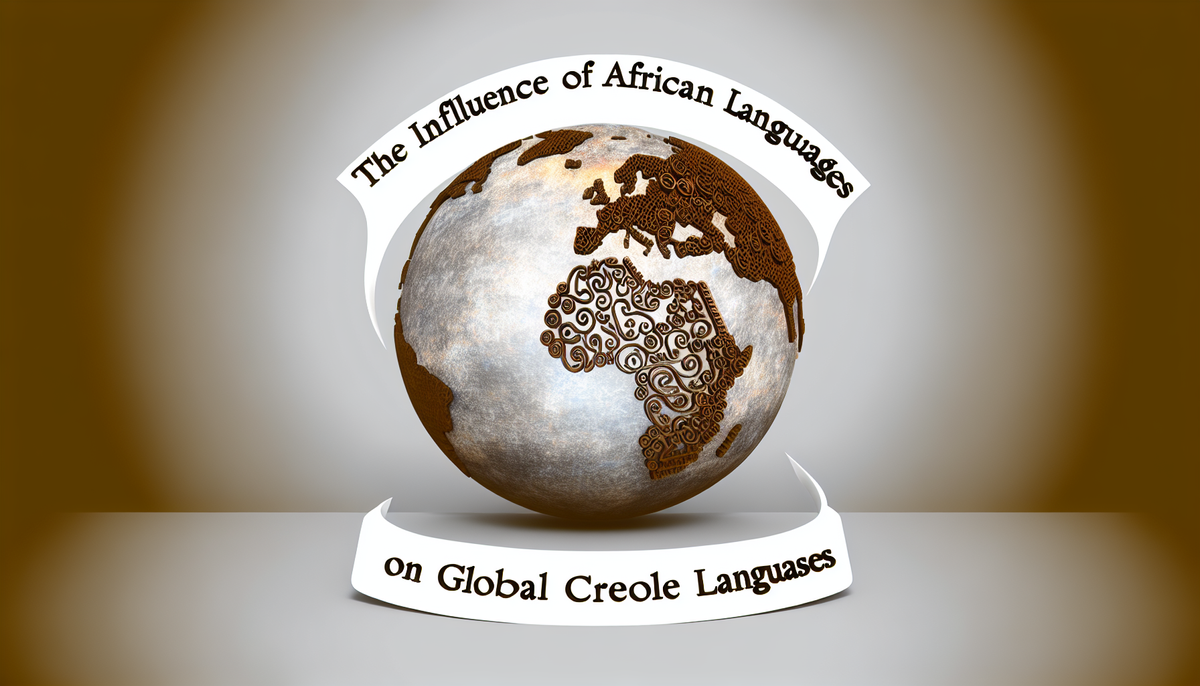The Influence of African Languages on Global Creole Languages

Introduction to Global Creole Languages and African Linguistic Contributions
Creole languages are fascinating linguistic systems that arise in contexts where speakers of different native languages come into contact, often due to trade, colonization, or the transatlantic slave trade. These languages typically blend elements from multiple origins, resulting in unique vocabularies and grammars adapted to the communicative needs of diverse groups. Among the myriad influences shaping creole languages, African languages have made significant contributions, driven largely by the forced migration of enslaved Africans.
As African slaves were brought to the Americas and other parts of the world, their native languages, including Fon, Yoruba, Kikongo, and many others, mingled with European languages such as French, English, and Portuguese. This blending is evident in vocabulary choices, phonetics, and linguistic structures of several prominent creole languages, including Haitian Creole, Cape Verdean Creole, and Louisiana Creole.
Understanding the influence of African languages highlights not only the linguistic diversity they brought but also their cultural significance. The interplay of these languages offers rich insights into the experiences of African diaspora communities, illuminating their resilience and adaptation in new environments. This exploration paves the way for a deeper appreciation of the interconnectedness of language, culture, and history in shaping global societies.
Historical Context of Language Development in Colonial Regions
The emergence of creole languages is deeply rooted in the historical contexts of colonialism, particularly during the 15th to 19th centuries when European powers expanded their territories across Africa, the Americas, and the Caribbean. This period was marked by significant social upheaval, as indigenous populations were often displaced or marginalized, and millions of Africans were forcibly transported to work as slaves on plantations. These interactions among diverse linguistic groups laid the foundation for creole languages.
Colonial administrators and slave owners sought effective communication with enslaved individuals and indigenous populations. As a result, pidgin languages often arose from interactions between European colonizers and enslaved Africans, featuring simplified grammar and limited vocabulary from the dominant language. Over time, these pidgins evolved into more complex systems, or creoles, as speakers began to use them in broader social contexts.
The influence of African languages was pivotal in this evolution, as enslaved Africans brought with them a rich linguistic heritage. With the blending of African phonetics and grammatical structures with European languages, creoles emerged as symbols of cultural identity, resilience, and adaptation. The historical narrative of language development in these colonial regions provides essential insights into the dynamics of power, culture, and identity during a turbulent era.
Case Studies: Haitian Creole and its African Roots
Haitian Creole, known as Kreyòl Ayisyen, stands as a prominent example of how African languages have influenced global creole languages. Arising in the context of French colonialism and the brutal system of slavery on the island of Saint-Domingue, Haitian Creole exemplifies the synthesis of various linguistic influences, primarily French and numerous African languages.
The development of Haitian Creole began in the 17th century when enslaved Africans, speaking diverse languages such as Fon, Yoruba, and Kikongo, were forced into a new sociolinguistic environment. To communicate among themselves and with their French masters, these individuals developed a creole that incorporated vocabulary primarily from French, but with significant phonetic and grammatical elements derived from African sources.
Research indicates that about 30-40% of Haitian Creole's vocabulary can be traced back to African languages. This influence is reflected not only in everyday speech but also in proverbs, songs, and cultural expressions that have survived through generations. Furthermore, the grammatical structure of Haitian Creole manifests features reminiscent of West African languages, such as the use of subject-verb-object order and the absence of inflections. These elements underscore the creole's cultural roots, making it a vital part of Haiti's national identity and heritage.
Lexical Borrowings from African Languages into Caribbean Pidgins
Caribbean pidgins and creole languages are rich tapestries woven from various linguistic threads, with a notable influence from African languages. The establishment of sugar plantations in the Caribbean during the colonial era led to the importation of enslaved Africans from diverse regions, each bringing their unique linguistic backgrounds. As these individuals interacted with European colonizers and among themselves, a lexicon emerged that reflected their multifaceted heritage.
Lexical borrowings from African languages into Caribbean pidgins can be observed in numerous vocabulary items, many of which pertain to agriculture, everyday life, and spirituality. For example, words such as "juba" (a type of dance) and "mama" (mother) are rooted in African linguistic traditions and have been adopted into various Caribbean languages. Such terms not only enriched the lexicon but also served as a means of cultural expression and identity.
Moreover, these borrowings facilitated the preservation of African cultural elements in a new environment. Through storytelling, music, and oral traditions, the African linguistic influence helped shape the identities of enslaved communities. Thus, lexical borrowings from African languages into Caribbean pidgins are a testament to the enduring impact of African culture, encapsulating resilience and continuity in the face of colonial adversity.
Grammatical Structures: Similarities Across Continents
The study of grammatical structures in creole languages reveals striking similarities that bridge continents, particularly between African languages and their Caribbean counterparts. This linguistic phenomenon stems from the rich African heritage embedded in the creole languages that developed during the colonial era. Despite their geographic separation, many creole languages exhibit grammatical features reminiscent of West African languages, showcasing the profound influence of African linguistic frameworks.
One notable similarity is the use of the subject-verb-object (SVO) sentence structure, which is prevalent in both African languages and Caribbean creoles. Additionally, the absence of tense markings in some creole languages reflects the grammatical simplicity often found in African languages. Instead, temporality is frequently conveyed through context or the use of auxiliary verbs, highlighting a shared approach to expressing time and action.
Furthermore, the use of reduplication, a way to indicate plurality or intensity, is common across many African languages and is also found in Caribbean creoles. This structural resemblance emphasizes the adaptability of enslaved Africans, who integrated their grammatical traditions into new languages while forming innovative systems of communication. Such similarities not only underscore the interconnectedness of linguistic evolution but also celebrate the richness of cultural exchange across the African diaspora.
Cultural Exchange through Language: A Pathway to Understanding
Language is a powerful vehicle for cultural exchange, serving as a medium through which ideas, traditions, and identities are expressed and shared. In the context of creole languages, particularly those influenced by African languages, this dynamic transpires prominently. The emergence of creole languages in the Caribbean, for instance, facilitated the blending of African, European, and indigenous cultural elements, creating a unique tapestry that reflects the history of colonialism and migration.
Through language, enslaved Africans preserved elements of their cultural heritage, embedding proverbs, songs, and storytelling traditions within newly formed dialects. Haitian Creole, for example, is imbued with African folklore and oral traditions, allowing for the transmission of cultural values and beliefs. The incorporation of African lexical items and grammatical structures into Caribbean languages fosters a sense of identity and continuity, linking present generations to ancestral roots.
Moreover, language as a cultural exchange tool promotes understanding between diverse communities. It opens avenues for dialogue and empathy, helping to bridge divisions created by historical injustices. By studying the ways languages have evolved and intermingled, we can better appreciate the rich cultural narratives they embody, fostering deeper connections and mutual respect among societies shaped by shared histories.
Future Directions: Preserving African Influence in Creole Languages
As global dialogue increasingly emphasizes cultural preservation, the future of creole languages—particularly those with strong African influences—calls for concerted efforts to safeguard their unique linguistic heritage. The interplay between language and identity is crucial, and preserving the African components within creole languages can enhance cultural pride and intergenerational transmission of traditions.
One strategic direction involves the integration of African linguistic elements into educational curricula, ensuring that younger generations appreciate and understand the historical contexts from which their languages have emerged. By fostering awareness of the African roots of creole languages, communities can cultivate a greater sense of belonging and pride in their heritage.
Furthermore, scholars and language activists need to document and promote indigenous African languages concurrently with creole languages, recognizing the symbiotic relationship that exists between them. Digital platforms, such as online dictionaries and social media, can be utilized to raise awareness and facilitate the learning of these languages, promoting a continuous cultural dialogue.
Additionally, collaboration between linguists, cultural organizations, and local governments can lead to initiatives aimed at revitalizing and celebrating creole languages through literature, music, and the arts. Emphasizing African influences within creole languages strengthens cultural identity and contributes to a more inclusive understanding of historical narratives in the contemporary world.



